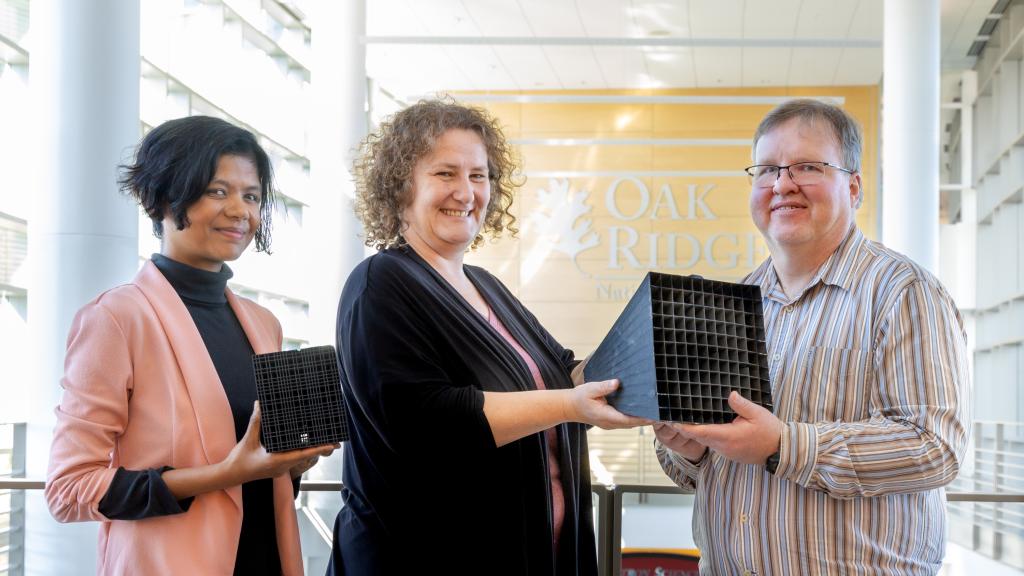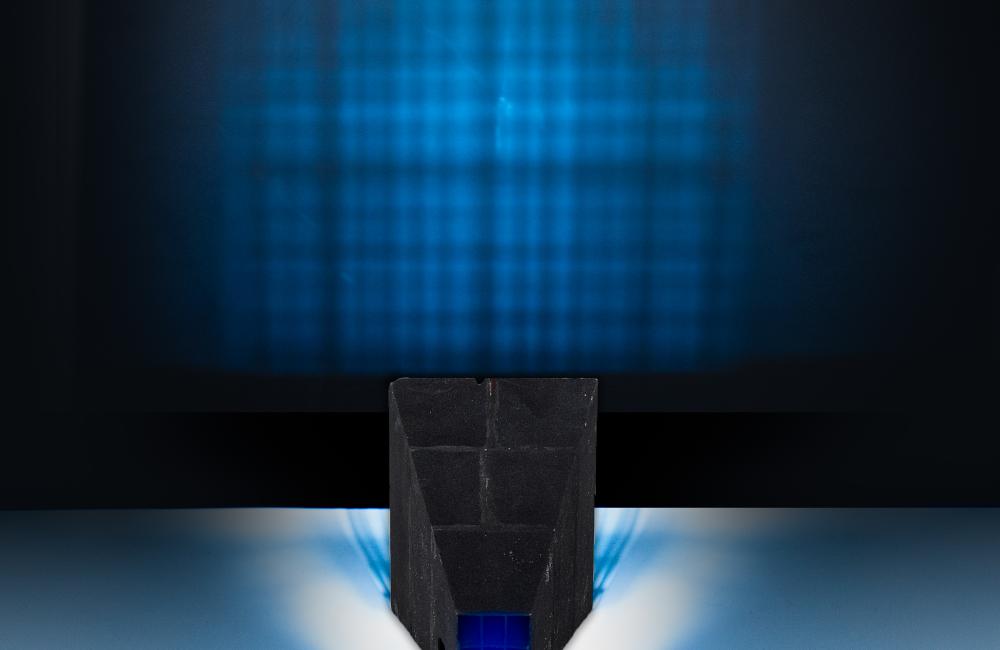ORNL’s 3D Printed Neutron Device Could Improve Physics Research, Medicine, and Nuclear Energy
In a novel approach to solving complex challenges in neutron scattering experiments, researchers at the Department of Energy’s Oak Ridge National Laboratory (ORNL) have applied 3D printing to develop a highly efficient neutron collimator. This development marks a significant advancement in the study of energy and matter at the atomic scale, leveraging neutron beams to gain insights into the structural and dynamic properties of materials.
Neutron collimators are essential tools in neutron scattering experiments, serving a similar purpose to funnels by directing neutrons towards a detector after their interaction with a sample. This process is crucial for minimizing the interference of stray neutrons that do not contribute to the desired data, similar to “gutters on a bowling lane, which capture bowling balls that are not headed toward the pins,” as an ORNL blog post describes it. These stray neutrons often arise from interactions with elements of the experimental setup other than the sample, such as sample holders or high-pressure cells, thereby obscuring the data with unwanted signals.
“The research trend toward using smaller samples of materials in more complex environments results in a larger number of neutrons that did not interact with the sample and are not scattering from the sample,” said Fahima Islam, the study’s lead author and a neutronics scientist at ORNL’s Spallation Neutron Source, or SNS. “These unwanted neutrons produce undesirable signatures in the data, which is why we were working to produce a 3D printed collimator that could be custom designed to filter out these unwelcome background features during different types of neutron scattering experiments.”
To improve collimator design, ORNL’s Spallation Neutron Source (SNS) team has been exploring the use of binder jet 3D printing over the past several years. Having already developed early models for 3D printed collimators, the SNS group scaled their designs to create a single, large collimator. The component measured 12 by 9 by 9 inches, which optimized the ability to direct neutrons toward the detector, while still ensuring the component fit within the existing system.

The team developing the 3D printed collimator included, from left, Fahima Islam,
Bianca Haberl and Garrett Granroth. Credit: Genevieve Martin/ORNL, U.S. Dept. of Energy.
However, binder jetting can lead to issues when producing larger parts, as cracking can occur during the curing and cooling process. In this case, the accuracy of the collimator decreased as the component was scaled in size, rendering it unsuitable for use in high-precision experiments.
“Simply scaling up the print as one large part with continuous blades was clearly not feasible without further optimizing the printing process,” said Garrett Granroth, a co-author and neutron scattering scientist at SNS. “A new concept was subsequently developed to print multiple smaller parts and then manually assemble them into a complete collimator. The main reason for using smaller pieces is that the cracking observed in the single-part design was primarily due to variations in the material’s contraction rate during the curing and cooling process. By reducing their overall size, the individual parts cooled more uniformly.”
To overcome these challenges, the researchers devised a solution by adopting a modular approach, creating the collimator from multiple smaller 3D printed parts. This “Frankenstein design,” as the ORNL team calls it, not only circumvented the issues associated with scaling but also introduced an innovative method for assembling precise scientific instruments. By printing and then manually assembling these parts, the team was able to manage variations in the material’s behavior during the curing and cooling processes, thereby enhancing the overall accuracy and performance of the collimator.

Images of the 3D printed “Frankenstein design” collimator show the “scars” where the individual parts are joined, which are clearly visible at right. Credit: Genevieve Martin/ORNL, U.S. Dept. of Energy
This alternative design strategy, featuring an array of progressively tighter blades from the sample to the detector end, enabled the creation of a collimator that could more effectively guide neutrons to the detector while minimizing the size-related limitations of 3D printing. The design’s success was further ensured through extensive simulation and computational analysis, allowing the team to move directly from design to production without the need for additional engineering modifications.
The performance of the newly developed collimator was tested on the SNAP beamline at SNS, demonstrating a significant improvement in the precision of neutron scattering data. The experiments underscored the critical importance of alignment in the collimator’s effectiveness, highlighting the potential for further refinements in manufacturing and assembly processes.
“To demonstrate the viability of using custom-built, 3D printed collimators, we decided to use a very small sample contained in a diamond anvil cell — a high-pressure chamber that uses diamonds to squeeze materials. Some of these cells are so complex and strong that they are capable of producing pressures approaching those at the center of the Earth,” said Bianca Haberl, the study’s corresponding author and a neutron scattering scientist at SNS. “In fact, high-pressure cells are some of the most complex environments used in neutron experiments, so it is a real challenge to filter out the huge amount of unwanted cell scatter they produce.”
Though neutron collimators are key to neutron scattering experiments, their applications extend beyond the lab, particularly in medicine, materials science, and nuclear energy and safety. In the medical field, they enhance neutron imaging techniques like radiography and tomography, offering unique insights into biological tissues and aiding in diagnostics and treatment developments. For materials science, neutron collimators facilitate the non-destructive testing of components in industries such as aerospace and automotive, enabling the detection of flaws or stresses without causing damage. In the realm of nuclear safety, these collimators improve the precision of reactor imaging and monitoring, thereby enhancing plant safety and efficiency.
Moreover, the work that the ORNL team has performed could be ported over to collimator design for other technologies, including collimation for X-rays, light, and other particles or waves. Although the specific design and material requirements may vary due to the different nature of particles being collimated, the principles of enhanced precision, efficiency, and modularity could advance those fields as well.
Subscribe to Our Email Newsletter
Stay up-to-date on all the latest news from the 3D printing industry and receive information and offers from third party vendors.
Print Services
You May Also Like
New Business: Temporary, Migratory, & Modular 3D Printed Architecture
If we look at potentially emerging 3D printing businesses, then architecture has not been fully explored. Yes, there is a lot of house 3D printing going on worldwide. From deployable...
3D Printing News Briefs, April 19, 2025: Material Extrusion Standard, Metal Powder, & More
In today’s 3D Printing News Briefs, we’re covering a proposed standard for material extrusion, before moving on to business and metal powder. We’ll end with a commercial store’s robotic 3D...
Japan Unveils World’s First 3D Printed Train Station
Japan is now home to what we believe is the world’s first train station built with 3D printing technology. Located in Arida City, just south of Osaka, the new Hatsushima...
restor3d Raises $38M to Expand 3D Printed Orthopedic Implants
Backed by $38 million in new funding, restor3d is pushing ahead with the launch of four personalized implant lines, set to roll out in 2025 and 2026. This latest venture...

























